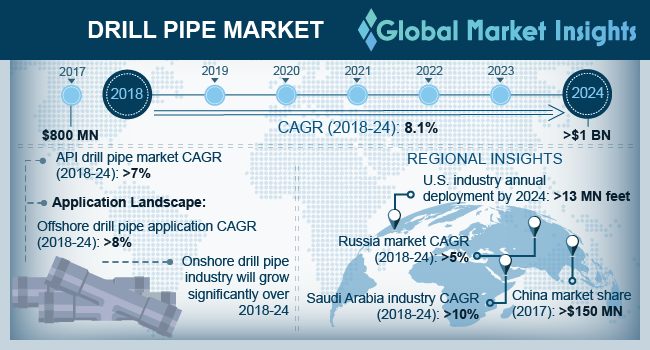Home > Energy & Power > Oil and Gas > Upstream > Drill Pipe Market
Drill Pipe Market Size
- Report ID: GMI796
- Published Date: Jul 2018
- Report Format: PDF
Drill Pipe Market Size
Drill Pipe Market size was valued over USD 800 million with annual deployment to exceed 35 million feet by 2024.

Growing investments across upstream sector coupled with ongoing exploration & production of unconventional resources including shale and tight gas will drive the drill pipe market size. The Kuwait Petroleum Corporation (KPC) announced an investment of over USD 115 billion across oil and gas between 2015-2020. Rising focus to reduce dependency on imports will further stimulate the industry growth.
Ongoing government ventures to increase crude production along with rising demand for petroleum products will positively impact the drill pipe market size. For instance, the federal government of Iraq, in 2018, announced its oil production target to reach 7 million bpd by 2022. Furthermore, wide availability of untapped reserves in combination with companies’ oil production targets will complement the business growth.
Rising investments toward technological enhancement with an aim to improve efficiency across the complete spectrum of E&P technology will stimulate the drill pipe market growth. Recent innovations including pad and horizontal drilling have reduced the downtime of drilling rig which in turn will propel the industry growth. Furthermore, development of extreme reach drill pipes for extended reach drilling will propel the business growth.
| Report Attribute | Details |
|---|---|
| Base Year: | 2017 |
| Drill Pipe Market Size in 2017: | 800 Million (USD) |
| Forecast Period: | 2018 to 2024 |
| Forecast Period 2018 to 2024 CAGR: | 8.1% |
| 2024 Value Projection: | 1 Billion (USD) |
| Historical Data for: | 2014 to 2016 |
| No. of Pages: | 410 |
| Tables, Charts & Figures: | 939 |
| Segments covered: | Product, Application, and Region |
| Growth Drivers: |
|
| Pitfalls & Challenges: |
|
Increasing primary energy consumption across regions including North America, Europe, Asia Pacific and Middle East & Africa will drive the drill pipe market share. As per BP statistical review, the global energy consumption increased by 4.3% between 2013 to 2017. Moreover, stabilizing crude oil prices coupled with changing demographics, increasing disposable income, and expanding population size will positively influence the industry landscape.
